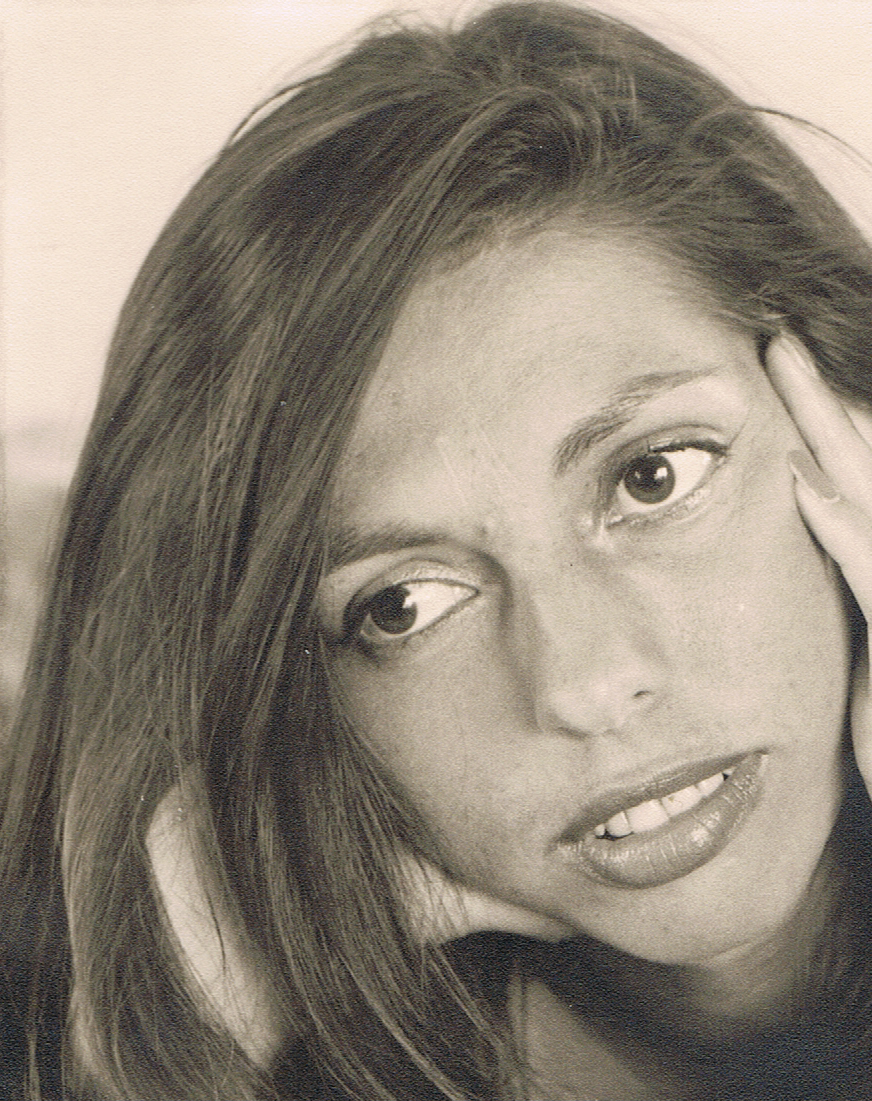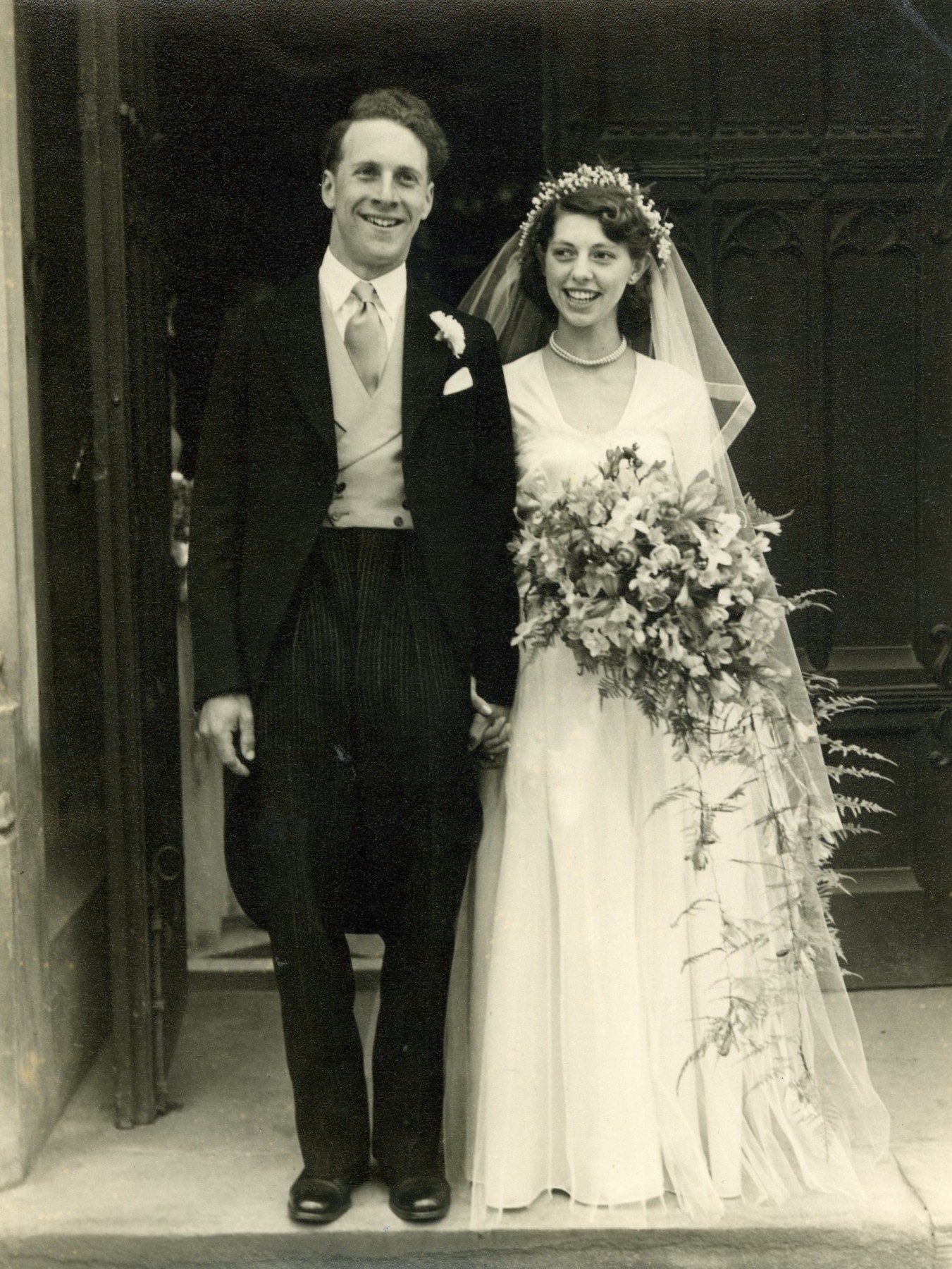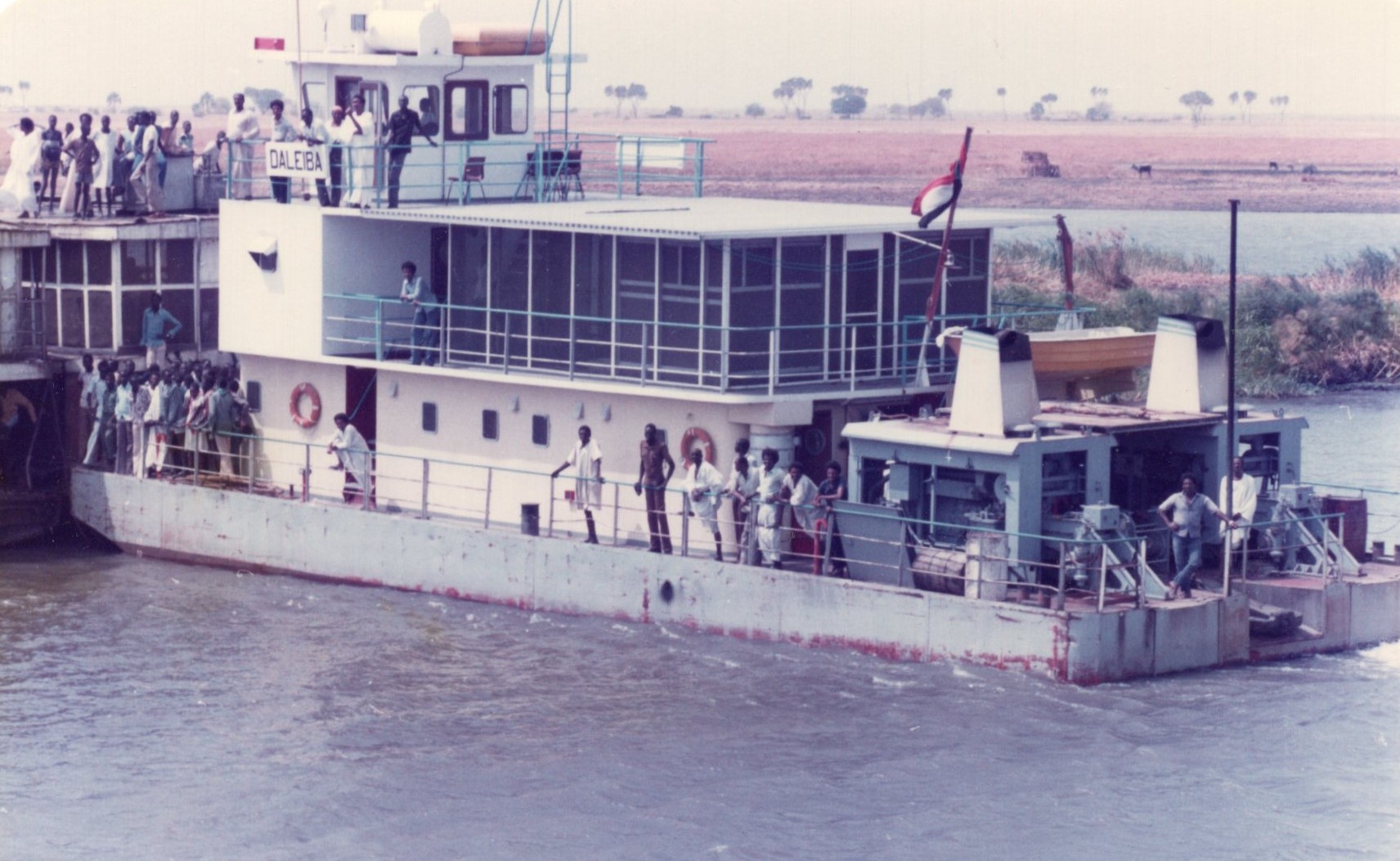Barbara Jerram, who died at Harrington House on 31st August 2024, aged 92, lived for over a third of her life in Badsey, the longest she had lived anywhere in the world. Most people in Badsey will remember Barbara as the elegant wife of retired Army colonel and first Chairman of The Badsey Society, Tony Jerram – someone who enjoyed creating a beautiful home, making magnificent floral displays, walking her beloved greyhounds and going on many exciting holidays.
But, before she came to Badsey, Barbara had been a farmer’s wife for seven years, met The Beatles and Rolling Stones, and had a life full of adventure, which took her to many parts of the world. One story she often related was about an epic trip up the Nile. But, before we get on to these adventures, first a piece of family background.


* * * * *
Early life and first marriage
Barbara Jane Watson was born in Cambridge on 27th October 1931, the only child of Evelyn James Denny Watson and his wife, Cissie Mary (née Watts). Her father taught at The Leys School, Cambridge. When war came, the school was evacuated to Pitlochry, so the whole Watson family moved north. Barbara loved her time in Scotland and, years later, called her son Garry, after the River Garry near Pitlochry.
 On 19th April 1950, aged 18, Barbara married George Michael Smout (known as Michael) in The Leys School Chapel, Cambridge. Michael, who was five years her senior and had been a pupil at The Leys, was one of five sons of Sir Arthur John Griffiths Smout, a Midlands industrialist. Sir Arthur had been knighted in 1946 for his services to industry, particularly during the war when he had been appointed a director of ICI and was Director-General of Small Arms Ammunition Production at the Ministry of Supply.
On 19th April 1950, aged 18, Barbara married George Michael Smout (known as Michael) in The Leys School Chapel, Cambridge. Michael, who was five years her senior and had been a pupil at The Leys, was one of five sons of Sir Arthur John Griffiths Smout, a Midlands industrialist. Sir Arthur had been knighted in 1946 for his services to industry, particularly during the war when he had been appointed a director of ICI and was Director-General of Small Arms Ammunition Production at the Ministry of Supply.
After the war, Sir Arthur bought Sheriffs Lench Farm and Michael became the farm manager. Thus Barbara began married life in Worcestershire where she and Michael lived in a new house built for them on the farm. The couple had three children.
Tragedy occurred when the family was on holiday in Beer in Devon in 1957. Barbara, Michael, the children, a maid and Barbara’s parents had not long been on holiday when Linda, the eldest child, was taken ill with polio and was transferred to an Isolation Hospital in Exeter. Michael then contracted polio. Whilst Linda slowly recovered, Michael succumbed to the disease and died within 48 hours. He was aged 31. Barbara, aged just 26, was now a widow with three children under four. She was in isolation with the rest of the holiday group, thus was unable to attend the funeral which took place at Church Lench on 27th July.
After Michael’s death, Barbara remained living at the Lenches. To try and find work, she used her artistic skills to do an interior design course in London (where she met The Beatles). This led to her doing the flower decorations at The Lygon Arms in Broadway (where she met The Rolling Stones and Prince Philip).
Second marriage
In 1973, Barbara married Tony Jerram, a major in the army. The wedding took place at Church Lench on 20th January. Barbara travelled with Tony to Berlin, Belize, the Sudan and Northern Ireland. Whilst in Berlin, they enjoyed going to the opera which was situated in East Germany. At that time (the 1970s), there were heavy restrictions to get into the East. As an army officer, Tony, who was stationed in West Germany, was able to pass with his wife through the Berlin Wall. They had to travel in an official army car driven by a uniformed soldier. They were not allowed to bring anything out, but somehow Barbara always managed to smuggle something through!
It was also whilst in Berlin, that Barbara suffered a further tragedy when her youngest daughter, Melanie, was killed in a car crash near Beckford in 1975.
It was perhaps the posting to The Sudan in the 1980s which was the most memorable. What follows is the story of Barbara’s adventures up the Nile: trying to keep ahead of the fighting that was taking over the country, an extended stay in Juba, and eventual rescue by the British Army.
In 2021, Barbara, then aged 90 and with failing memory, asked me to write down her story about her adventures travelling upstream along the Nile nearly 40 years previously. Barbara found some photos taken at the time and together we were able to piece together her story. Using contemporary travel books of the time and the slender resources available on the internet, this is the tale of Barbara’s epic journey in 1984.
* * * * *
Arrival in The Sudan
In 1983, Tony Jerram was posted to The Sudan; his job was to train the Sudanese army in warfare. Tony and Barbara moved into a lovely villa in Khartoum. The night-watchman said they needed a guard dog. One evening, he banged on the door and presented Barbara with a miniscule puppy as his present to her. The watchman’s name was Adam, so of course the puppy was called Eve. Eve grew into a beautiful dog and ultimately came back to England with Tony and Barbara – though she didn’t much like the cold. Tony played polo and they had a number of good friends in Khartoum.
It was an “interesting” time for the Jerrams to be in the Sudan. Since 1969, Colonel Jaafar el-Nimeiry had taken over the country in a coup. He ruled over the Sudan for the next 16 years, surviving a number of attempted coups. His one major achievement was the ending of the civil war in the 1970s. He achieved this by granting the south a wide measure of autonomy. In late 1983, however, Nimeiry, either through over-confidence or, as some suspected, senility, abruptly scrapped the autonomy accord with the south in favour of “regionalisation” and imposed Islamic Law on the whole country. Within a couple of months, the central government virtually lost control of the south as the railway was sabotaged, the Kosti-Juba ferry was blown up and roads were mined.
It was in this climate that Barbara set off on her adventure.
Two go up the Nile

Early in 1984, Barbara and a female friend decided to venture out of Khartoum and take a trip up the Nile. (By 2021, Barbara could no longer remember the name of her travelling companion, but thought her friend might have been called Carol and was the wife of a diplomat rather than an army wife.) Their journey began with a day-long bus trip to Kosti, 193 miles (310 km) by road south of Khartoum. The 1983 edition of Africa on a Shoestring says that an express bus, costing 7 Sudanese pounds (equivalent then to £4.75), took six to eight hours, confirming Barbara’s memory. Kosti was the northern terminus of the Sudan’s White Nile ferry service. The service plied nearly 800 miles of river, making a tenuous connection between the Arab, Muslim north and the black, African south. Today the southern section is in the new nation of South Sudan with Juba as its capital.
A traveller writing in 1963 described Kosti as “a town that is little more than a dusty street with a few shops and a neglected railway station. The only way south from this remote part of the country was aboard a crudely constructed vessel that wends its meandering way along the Nile through the Sudd swamps to Juba.”
The Sudan Embassy website says that currently Kosti sits in an area that’s usually considered safe, but that the Nile steamer that used to travel from Kosti to Juba is not currently in service. Barbara and companion were amongst the last people to travel along this route – for 40 years there has been no passenger service (although there is now a new road running from Khartoum).
An article by Bruce MacDonald, an American journalist, written in 2016 about his journey in 1983 on a Nile steamer from Kosti to Juba gives a vivid picture of the journey that Barbara would have undertaken just a few months later. In introducing us to his 1983 article, he begins by saying: “Despite the rigors of the trip, those were halcyon days, passed in a rare interval of peace between northern and southern Sudan, and well before the sleepy towns described here were torn apart by competition for oil and civil war. I have left the article unchanged, in homage to a unique place in time, forever gone, and to what was once a slightly bigger world.”
On arrival in Kosti, Barbara and her companion spent a night sleeping on the river-bank before boarding a boat the next day. There were options to travel on an old boat or a new boat. The old boat was just half a dozen old barges joined together and pulled by a paddle steamer. The new boats (Africa on a Shoestring refers to just two, Juba and Nimule, but it becomes apparent from other sources that there were also other boats plying the route) had more facilities and were much quicker, taking six to eight days upstream as opposed to 11 days on an old boat.
Barbara and friend opted for a new boat, booking a first-class berth. But the berth was first-class in name only. In Barbara’s words, it was “unbelievably ghastly – quite revolting”. Africa on a Shoestring has this to say about the boat: “Water comes straight from the river and is not boiled. You’ll also need insect repellent. The toilets get sluiced down daily but they don’t stay in that condition for very long.”
“You can say that again,” said Barbara, who spent a long time with her friend scrubbing down their cabin before they could begin to think about sleeping there.

Bruce MacDonald travelled on a boat named Hurriyah. We can see from Barbara’s photos that she was on a boat named Daleiba, but presumably they were similar. He describes his cabin thus:
“Take two buckets,” someone had said. Use one as a latrine, the other for scooping water from the river to drink. The reason for the siege mentality became apparent after boarding the boat that first morning. As we opened the door to our first-class cabin, a rat ran out. The reading lights had been torn from their fixtures. Cobwebs hung from the ceiling, and dirt and graffiti were smeared across the walls.
He goes on to describe another of the boats, though this was probably the old boat that Barbara did not go on:
Propulsion is still by paddle wheel, though powered today by diesel, not steam ….. The barges have remained virtually untouched since their launch on the river 45 years ago. The British royal crest still decorates the cut-glass windows, even though the screens on the upper deck are torn, the doorknobs fall off, and poor Sudanese camp where English colonial officers once sipped gin. And though the restaurant’s walls are now covered in soot from the kitchen’s cooking fires, and light at night comes from one dim, naked bulb, a service call button remains next to each table, another reminder of a once-elegant way to travel.
The Journey Up-River
Despite the rigours of the boat, Barbara found the whole trip totally fascinating. She had particularly fond memories of travelling through the Sudd and, in later life, particularly enjoyed watching TV programmes about this remote area. It was like travelling through a field. The channels were very narrow, at some points no wider than the width of a dining-room table. Brian MacDonald describes the journey:
At first the river is several hundred yards wide, its brown waters bordered on either side by yellow grasslands stretching back to a line of trees on the horizon. Several high, rocky jebels, or hills, lend variety to the landscape, but they are soon left behind and the savannah stretches away again uninterrupted. The boat passes cattle grazing on the foreshore; the reed huts of the Shilluk people; a dugout canoe lying on the bank. Fires rage across the marshland, torched by herdsmen to burn off the old grass and encourage new growth. The horizon at night is indigo and orange.
Just upriver from Malakal, where the Sobat River enters the main stream, the ferry swings west onto the last stretch of open river anyone will see for almost 250 miles and four days. The vegetation changes almost overnight, and by the time the boat reaches Lake No, the wide, flat marshland has given way to the reeds and papyrus of the Sudd. The river loses itself in this swamp, and winds and winds, looking for a way out.
The Fighting begins
It was part way through Barbara’s journey that the fighting began and one of the Nile steamers was attacked. Their boat carried on (it didn’t have much choice), trying to keep ahead of the fighting. A report in a newspaper of 16th February 1984 gives an account of the boat which was attacked:
AROUND THE WORLD; Sudan Guerrillas Report Attack on Nile Steamer
A spokesman for a Sudanese guerrilla group said today that it made a bazooka attack on a Nile steamer this week and captured 222 soldiers on board. In Khartoum, the official Sudanese press agency said fire had broken out aboard a barge trailed by a Nile steamer with 300 people aboard on Monday. The agency said no casualties were reported. In London, the guerrilla spokesman, Benjamin Ball, said the guerrillas had sunk the steamer and rescued and released 36 civilians. He said the guerrillas were still holding 222 soldiers taken in the incident at Wadh Kei on the White Nile two or three days ago. The Sudanese press agency said the barge caught fire near Adok in the Upper Nile province. ''The steamer's engineer managed to disconnect the barge from the steamer, avoiding a disaster, and the fire was extinguished,'' the agency said.

A further report of 19th February 1984 stated:
AROUND THE WORLD; Sudan Troops Said to Kill 30 Rebels in a Clash
A military commander says Sudanese troops killed 30 rebels who had attacked a Nile River passenger steamer earlier this week, the official press agency reported today. The army ''is now in full control of all areas in south Sudan which outlaws infiltrate to carry out their criminal sabotage activities,'' the agency quoted Gen. Abdel-Rahman Sewar-el- Dahab as saying Friday. The agency reported today that all but 14 passengers and 2 crew members had been accounted for. There were 800 passengers aboard the steamer Hegliga and the six barges it was towing when it was attacked Monday. The raid occurred near Waskeing, about 500 miles south of Khartoum. Sudanese officials said the rebels were infiltrating from neighboring Ethiopia after receiving military training.
Stay in Juba and Rescue by the Army
Eventually the boat got to Juba. Barbara recalled that her travelling companion had an uncle or a friend who lived in Juba and they were able to stay with him. It was very hot, and they each had just one dress to wear, reaching down to the ground. They had plenty of time to walk and explore the place and, despite the developing situation, Barbara felt it was a very interesting time to travel. Africa on a Shoestring describes Juba as: “… definitely a ‘one-horse town’, though many people do grow to like it.”
It was some four to six weeks before a rescue could be mounted. Originally I had visions of Tony Jerram and colleagues storming through the swamps of the Sudd in order to find their wives, but it wasn’t quite as dramatic as that. Back in Khartoum, Tony and the husband of the friend, were able to organise an aeroplane to take the two travellers back. Barbara had had an exciting time, but the war put paid to any further adventures.
* * * * *
The move to Badsey

In 1988, as Tony was nearing the end of his military service, Barbara and Tony moved to Harrington House when Tony began a civilian job at GCHQ in Cheltenham. They became very involved in village life; Barbara was a great support to Tony when he became the first Chairman of The Badsey Society in 2002.
It was a great shock when Tony died suddenly of a heart attack in April 2008. Following his death, The Badsey Society committee decided to present an annual award in his memory, which was to be given to someone who had contributed greatly to the community of Badsey or Aldington. Until ill-health prevented her from doing so, Barbara attended the AGM each year to present the award.
Barbara remained at Harrington House until her death two months ago. As her neighbour of 30 years, it has been my privilege to have known Barbara.
Maureen Spinks, October 2024
Sources of Information
Africa on a Shoestring, 1983 edition, Geoff Crowther, Lonely Planet
Africa on a Shoestring, 1986 edition, Geoff Crowther, Lonely Planet
Steaming Through Africa, Bruce MacDonald, 2016 account of a journey in 1983
Wikipedia article on Arthur Smout
